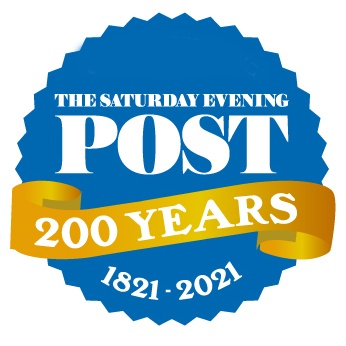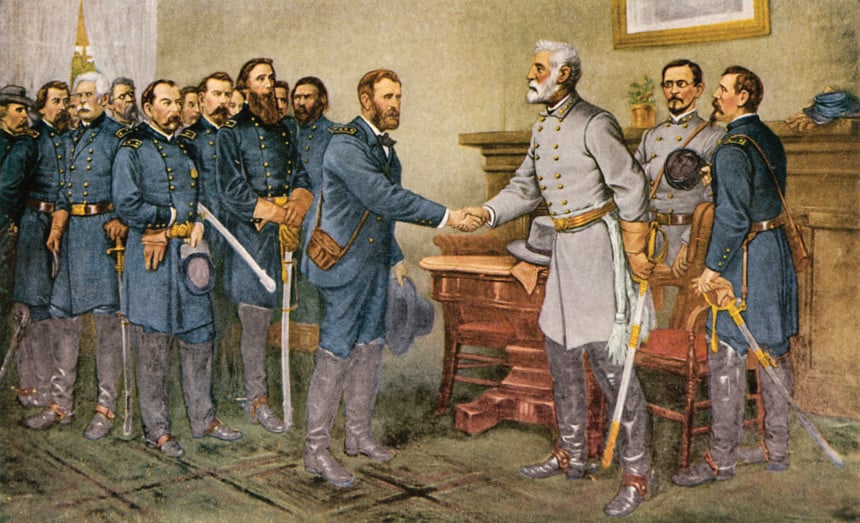The Saturday Evening Post turns 200 this year, so we are bringing you excerpts from our archive to celebrate our long history. Seth M. Flint, an 18-year-old bugler attached to Gen. Ulysses Grant, was present at Appomattox for the truce ending the Civil War. At the age of 93, he shared his memories of that historic meeting in an article from our April 6, 1940, issue.
On the morning of April 9, 1865, a horseman at top speed was seen coming from our front lines; as he drew near, I recognized him as a young lieutenant of Gen. Meade’s staff. He pulled his horse back on its haunches and handed a paper to Grant from Lee.
I gathered that the drift was that the Confederate leader had agreed to meet Gen. Grant, but evidently the staff officers construed this to be assurance of surrender, for every last man of them burst into cheers as General Grant looked on with bland amusement.
There was a half-decayed log lying by the roadside, and Grant sat down on it, calmly pulled a cigar from his cigar case, and, requesting one of his staff who stood nearby to furnish him a sheet of paper, he dug up a pencil from his pocket, hastily wrote a reply.
[The author then joined a small party carrying a white flag to ride toward enemy lines to deliver Grant’s letter, still unsure whether the meeting requested by Lee was a ploy or had been offered in earnest.]
As we neared their lines, the colonel ordered a halt, and the staff officer, his white flag conspicuously displayed, rode on toward the gray-clad horsemen.
“I’ll wager that’s General Lee,” said the captain, with a glance at me. “Let us hope things turn out all right.”
As the two Federals neared the spot, a man arose and they exchanged salutes. He was tall, erect, and of fine physique. For a few moments they carried on what appeared to be a friendly conversation, much to our relief; and then the entire group started down the road toward us.
It was not difficult to recognize the famous commander of the Army of Northern Virginia. He measured up fully to my expectations. Though I was a lad of only 18, I had been in 15 or 16 battles during three years, and had come to have a wholesome esteem for the Johnny rebs and their leader. In my active imagination, he had become a sort of legendary figure.
Well, there he was in person, he and his horse, Traveler. General Lee’s uniform was immaculate, and he presented a superb martial figure. But it was the face beneath the gray felt hat and hair that made the deepest impression on me; I say this because I can still recall it vividly. I have been trying to find a single word that describes it, and I have concluded that benign is the adjective I am after; because that means kindly, gracious; and despite its sternness on that day of long ago, I would still call his expression benign. And yet, I remember well that there was something else about him that aroused my deep pity that so great a warrior should be acknowledging defeat.
We joined the little party and rode slowly on until our guide stopped before an old-fashioned structure with chimneys at the gable ends; and, running along the front, a piazza painted white, with six wooden pillars supporting it.
General Lee and the colonel dismounted and went into the house, leaving their horses in charge of the orderly; and we Yanks returned to the roadway to await the coming of Grant and his party.
It was perhaps ten minutes later — it may have been only five — when the Federal commander rode up with a few staff officers, the other members of the escort, and several Union generals, among them George Custer, who stood out, both for his attire — red necktie, buckskin breeches, and a velvet jacket — and for his patrician face with mustache and small goatee, and a head of luxuriant yellow hair that fell halfway to his shoulders.
Grant looked an old and battered campaigner as he rode into the yard. His single-breasted blouse of blue flannel was unbuttoned at the throat, and underneath it could be seen his shirt or undershirt; his top boots were spattered with mud, and splotches of mud were on his trousers. Unlike Lee, he wore neither sword nor sash, and the only marks of his rank were his shoulder straps.
Without more ado Grant climbed the steps, accompanied by several officers.
It was now about two o’clock, and we fellows who were on the outside were in for a long and anxious session of waiting. There we were, a group of eager troopers in blue, and a lone orderly in gray. When three o’clock came and went, I began to wonder if our enthusiasm had exploded too quickly. It did not seem necessary to take all that time in deciding whether Lee should surrender or not. With the thoughtlessness of youth, I assumed that such a decision would be the matter of but a half hour at the most.
Four o’clock — and the door opened. Out came General Lee with a somber face. The conference was ended, but with what results?
We quickly learned the happy news, and it spread like wildfire through the army. Cheers could be heard all along our lines.
That night was one of the happiest I have ever known, and I will wager that the same statement goes for every man on the Union side. A gun salute in celebration had been started by enthusiasts in the late afternoon, but Grant had put a stop to it, presumably out of consideration for the feelings of the other fellows. But, before darkness fell and afterward, there was music — patriotic selections played by the regimental bands — and a general jubilation. When I sounded taps, that sweetest of all bugle calls, the notes had scarcely died away when from the distance — it must have been from Gen. Lee’s headquarters — came, silvery clear, the same call; and, despite the sadness of the hour to the boys on the other side, I have a notion that they, like the Yanks, welcomed the end of hostilities and the coming of peace.
—“I Saw Lee Surrender,” April 6, 1940
This article is featured in the January/February 2021 issue of The Saturday Evening Post. Subscribe to the magazine for more art, inspiring stories, fiction, humor, and features from our archives.
Featured image: At long last, peace: After four brutal years of Civil War, Grant accepts Lee’s surrender on April 9, 1865, at Appomattox in this painting by Thomas Nast. (Shutterstock)
Become a Saturday Evening Post member and enjoy unlimited access. Subscribe now




Comments
This account by Mr. Flint for the Post in 1940 at age 93, of an event 75 years earlier, in such detail, is astonishing. I can visualize what he’s saying to a fairly good extent, I think, for someone born close enough to 100 years later. He must have kept a journal of the events, or simply had a brilliant memory time had not diminished.